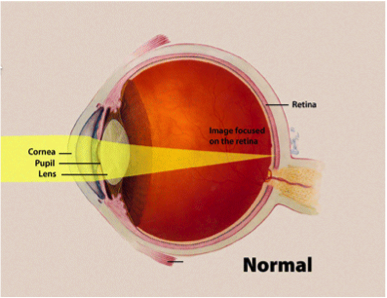When undergoing any medical procedure, you want to make sure you have a solid understanding of every aspect. Like most of us, you’ll do your research, looking up terms on Google and reading up on all the latest news. And when you begin any kind of research, you want to start with the very basics. With that in mind, here’s a helpful summary that’s all about how the eye works and how LASIK eye surgery can help.
Once you’ve done your research, the next step is to find out if you are a candidate for LASIK. You can schedule a FREE* exam at Loden Vision Centers to find out more, and we’ll answer any additional questions you have
Your Eyes: The Camera Analogy
The best way to understand how something works is to compare it to something you’re already familiar with. In this case, we can better understand the eye by comparing it to a camera.
Labeled diagram of the human eye with image focused on the retina
 External Camera Lens: The Cornea
External Camera Lens: The Cornea
The cornea (the eye’s outer surface) works like a camera’s external lens. The cornea serves as the eye’s primary focusing tool, bending light rays through the pupil.
Camera Shutter: The Iris
Next is the iris, which works similar to a camera’s shutter. It widens and narrows the pupil in order to control the amount of light that enters in.
Internal Camera Lens: The Lens
As you may have already guessed, the lens is very similar to the internal lens on a camera. It helps focus light into the back of the eye.
Film: The Retina
The back of your eye is lined with a layer known as the retina. The retina operates in a similar way to the film inside a traditional (non-digital) camera. The middle part of the retina (known as the the macula) takes care of your sharp vision, or reading vision, and the outer part takes care of your peripheral vision. Your retina’s nerve cells change light rays into electrical impulses and then send them to the brain through the optic nerve.
Developer: The Brain
To make sense of the images taken from a camera, you need to develop the film. This is where the brain comes in. Your brain essentially works by processing the electrical impulses and converting them into the objects that you see.
LASIK Can Help Fix Broken “Cameras”
Since the mechanisms of your eye operate like a camera, some of the parts can experience problems that may adversely affect your vision. You may experience nearsightedness (myopia), which can occur when the eyeball is too long or because of other refractive errors from the lens or cornea. Additionally, you may have farsightedness, or hyperopia, which is caused by the eyeball being too short or due to other cornea- or lens-caused refractive errors. Another common issue is astigmatism, which is when the eye is shaped more like a football than round like a basketball. Finally, presbyopia occurs when the lens inside the eye begins to harden and thicken with age. The eye muscles can no longer change the inside lens’ shape to focus on near objects, resulting in blurry or out of focus vision. Whatever issues you face, it’s important to understand how and why they are occurring.
The good news is that LASIK can correct most of these vision problems. LASIK uses a laser to reshape the cornea so light rays focus on the retina (instead of in front or behind it), providing clear vision. Click here to learn how Loden Vision Centers uses LASIK to correct common vision problems. You can also take our brief quiz online to see if you are a good candidate for an LASIK procedure. Loden Vision Centers can bring you closer to experiencing the JOY of clear vision.
*No-Show Fee: There is a $50 no-show fee if you are unable to keep your appointment and do not cancel 24 hours prior to your scheduled appointment time.


